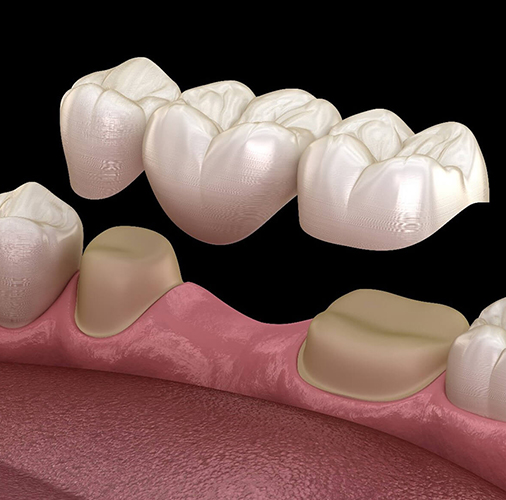
Dental Bridges
If you are missing a tooth, a bridge can be an option to restore a gap. A bridge requires healthy teeth adjacent to a gap to hold the prosthetic unit. A bridge can be suspended from one tooth as a cantilever or fixed onto a tooth on either side.
Your dentist at Mouth will assess your teeth for your suitability for a bridge as it depends on the size, location and the health of the intended support teeth.
Here Invisalign was carried out first to align the teeth and then a new bridge was placed on upper left with improved angulation and space widths.


TYPES OF BRIDGES
The prosthetic unit which replaces the gap needs to be joined onto either a crown or a metal type wing, which is cemented or bonded onto the tooth.
Conventional bridges are bridges which are retained onto the tooth by a crown. This requires tooth preparation and some reduction of tooth substance to create space to fit into the mouth.
Resin bond bridges (also known as Maryland bridges) require little or no tooth preparation and the prosthetic tooth unit is suspended form a thin metal wing. We can now make the wings in tooth colour too. This is only suitable in optimal bite situations and can be more prone to decementation. However, tooth more tooth structure is preserved in case an implant is preferred in the future.




BRIDGE APPOINTMENTS AT MOUTH
STEP 1
The old existing filling on the anchor tooth is sometimes changed to a fresh new one to ensure the base of the new bridge is built on new and strong foundations. For a conventional bridge, the tooth is then trimmed to create space same as for a crown. For a resin bonded bridge, this would only be a light modification of the tooth surface.
A digital scan or impression is taken to send to our affiliated dental laboratories to create a bridge. Photos are sometimes taken to ensure the colour and characteristics of your bridge matches your own teeth as best as possible.
A temporary crown or bridge is cemented on if conventional.
STEP 2
The next appointment is usually 2-3 weeks later. The temporary crown or bridge will be removed and the new bridge will be tried in to check for fit and appearance. If all is well, it will be cemented on.
MEET YOUR DENTISTS FOR BRIDGES AT MOUTH NINE ELMS
DENTAL BRIDGES VS IMPLANTS
Why choose us to get you dental bridges done?
We offer you a professional and caring service after our experts assess and review your specific dental requirements.
Book your virtual consultation
Begin your personalised smile transformation at Mouth Dental.
Book your free consultation with us now and let’s discuss treatment options to help you get that perfect smile!

Frequently asked questions
HOW LONG DOES A DENTAL BRIDGE LAST?
A dental bridge should last around 5-15 years, depending on your anchor tooth structure, bone support, bite, oral hygiene and diet. We recommend check ups and hygiene appointments every 6 months as good oral hygiene and diet is fundamental to the longevity of the bridge.
AFTER LOSING A TOOTH, WHEN WILL I BE READY FOR A DENTAL BRIDGE?
After a tooth extraction, the socket needs to close and heal. The bridge preparation and scanning or impressions is recommended 2 months after the tooth extraction. If the bridge is made too early before the socket has completed healing, a small gap may appear beneath the prosthetic tooth. Conversely, if you leave the gap too long and don’t wear a retainer or have a denture, then the adjacent teeth can tilt into the gap, causing poor angulation and suboptimal space distribution.
HOW DO I KEEP A BRIDGE CLEAN?
If the bridge is only joined on one side, you can floss beneath the prosthetic tooth from where there is no join. If the bridge is joined on both sides, you will need to use Oral B Superfloss to floss beneath the prosthetic tooth.
